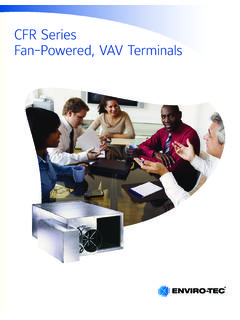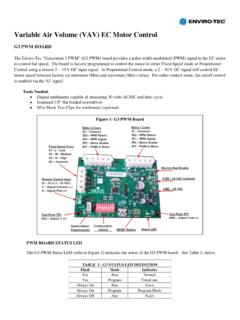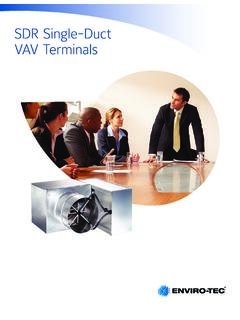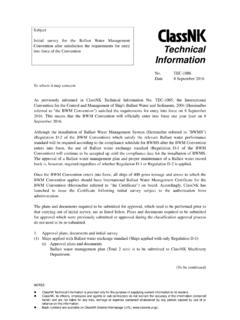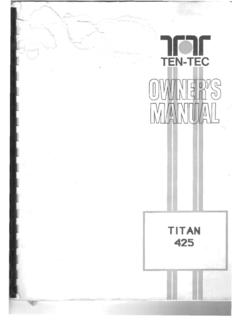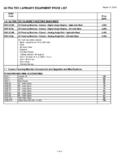Transcription of VAV TERMINALS - ENVIRO-TEC
1 FAN POWERED. VAV TERMINALS . Models CFR, CFRQ, CFL, VFR, VFL. INSTALLATION, OPERATION. AND MAINTENANCE MANUAL. IOM-VAVFAN. September, 2006. 2006 Environmental Technologies Largo, FL PX-00-0031. Fan Powered VAV IOM. Safety Considerations and Inspection .. 3. Storage, Pre-Installation 4. Sequence of 5. 5. Operation .. 7. Maintenance .. 10. Electric Heat .. 12. Troubleshooting, General .. 13. Troubleshooting, ECM Specific .. 14. Valve Calibration Charts .. 16. Fan CFM Calibration Curves .. 17. Series Flow terminal Unit 18. Parallel Flow terminal Unit 19. Replacement Parts 19.
2 2 Fan Powered VAV IOM September, 2006 Environmental Technologies, Inc. Fan Powered VAV IOM. SAFETY CONSIDERATIONS. The equipment covered in this manual is designed for safe and reliable operation when installed and operated within design specification limits. To avoid personal injury or damage to equipment or property while installing or operating this equipment, it is essential that qualified, experienced personnel familiar with local codes and regulations perform these functions. See the following cautionary statements. DANGER. ELECTRICAL SHOCK HAZARDS. All power must be disconnected prior to installation and servicing this equipment.
3 More then one source of power may be present. Disconnect, tag and lock out all power sources to avoid electrocution or shock hazards. ROTATING EQUIPMENT HAZARD. Fans may start automatically. Disconnect all power and control circuits prior to servicing to avoid injury. Caution should be exercised due to the possibility of fans free wheeling due to connected duct air movement. HOT PARTS HAZARD. Electric heaters may start automatically. Disconnect all power and control circuits prior to servicing to avoid burns. WARNING. Check that rigging and lifting equipment can safely support the equipment assembly and component weights.
4 All assemblies must be adequately secured during lifting and rigging by temporary supports and restraints until equipment is permanently fastened and set in its' final location per manufacturer's guidelines. All temporary and permanent equipment supports must be capable of safely supporting the equipment's weight as well as any additional live, seismic or dead loads that may be encountered. All supports must be designed to meet applicable local codes and ordinances. All fastening devices must be designed to mechanically lock the assembly in place without the capability of loosening or breaking away due to system operation and vibration.
5 CAUTION. Dampers may activate automatically. Disconnect the control circuits or pneumatic control systems and secure all dampers when servicing damper, actuators or linkage to avoid injury. Wear the appropriate personal protective equipment (gloves, safety glasses, leather closed toe shoes, etc) when handling this equipment recognizing that sheet metal components are being handled. INSPECTION. Upon receipt of equipment, carefully check all items against the bill of lading to ensure that all equipment has been received (including shipped loose items). Note any discrepancy on the bill of lading before signing.
6 Note that ship loose items may be included with the base unit or shipped (bulk) on a separate pallet. Inspect all equipment for any signs of damage caused during transit. On equipment with electric heat, make sure to check the coil fins and/or make sure that the resistance heat coils are not damaged. Note any visual damage on the bill of lading before signing. Immediately report all visual and concealed damage to the carrier and file a claim with the carrier. Locate the model number on the nameplate and check that the correct equipment has been received. Verify that all options have been included, such as controls, filters, heating coils, etc.
7 Also check that equipment voltage agrees with the building parameters. If a discrepancy is discovered between what was ordered and received, contact your local Environmental Technologies representative immediately. September, 2006 Environmental Technologies, Inc. Fan Powered VAV IOM 3. Fan Powered VAV IOM. CAUTION: DO NOT USE FLOW SENSOR, CONNECTING TUBES, COIL STUBOUTS OR DAMPER SHAFT AS A HANDLE. WHEN LIFTING OR MOVING EQUIPMENT AS DAMAGE MAY OCCUR. DO NOT HANDLE BY EQUIPMENT'S HEATING ELEMENTS, AS PERMANENT DAMAGE WILL OCCUR. Warnings CHECK assembly and component weights to be sure that the rigging equipment can handle them safely.
8 Note;. also check the centers of gravity and any specific rigging instructions. CHECK for adequate ventilation so fumes do not migrate through ductwork to occupied spaces when welding or cutting around the equipment. DO NOT work on damper until their actuators are disconnected. Cautions NEVER pressurize equipment above specified test pressure. PROTECT adjacent flammable materials when brazing. Use flame and heat protection barriers where need. Have a fire extinguisher at hand and ready for immediate use. STORAGE. If equipment is to be stored prior to installation, observe the following precautions: 1.
9 Choose a dry storage site that is reasonably level and sturdy to prevent undue stress or permanent damage to the equipment. Set equipment off ground if in moisture prone areas. 2. Cover entire equipment with protective tarp or moisture proof cover. Extend cover under equipment if stored on ground. Secure cover with adequate tie downs. Be sure that piping connections have protective shipping caps installed. 3. Do not stack equipment any higher than how it was shipped. If equipment has been unpackaged since receipt from the factory, do not stack without equivalent support between units as was supplied from the factory.
10 PRE-INSTALLATION INSPECTION. CAUTION: DO NOT USE FLOW SENSOR, CONNECTING TUBES, COIL STUBOUTS OR DAMPER SHAFT AS A HANDLE. WHEN LIFTING OR MOVING EQUIPMENT AS DAMAGE MAY OCCUR. DO NOT HANDLE BY EQUIPMENT'S HEATING ELEMENTS, AS PERMANENT DAMAGE WILL OCCUR. While viewing the damper from the discharge of the equipment, disengage the actuator by depressing the manual override button on the side of the actuator and rotate the shaft fully. The damper should close fully and there should be no gaps between the damper gasketing and the inside of the valve. Units equipped with ECM or 1 Horsepower motors will ship from the factory with a removable motor / wheel support installed in the fan housing.
